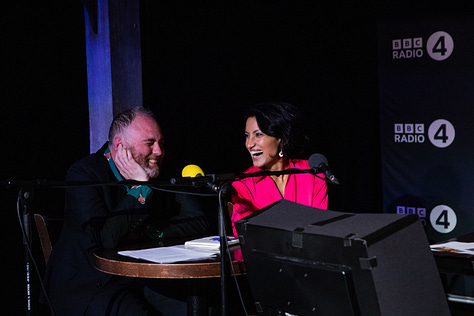





Back on BBC Radio 4’s Best Medicine again this week, arguing with another set of clever people. Since my suggestion that gardening was best medicine wasn’t so convincing, this time I tried to convince Kiri and my fellow panelists that embroidery was the best medicine.
If you missed the broadcast, here it is on BBC Sounds.
To understand why embroidery is the best medicine, we have to go to Lyon at the end of the nineteenth century.
It was 25th June, 1894. Crowds were lining the roads to the Chamber of Commerce in Lyon. French President, Marie François-Sadi Carnot, was having a banquet inside. The throng was still there when his carriage pulled up to collect him. A man shot out of the multitude and dropped a rolled-up newspaper from under his arm. He was wielding a dagger, which he stuck into the president’s back. The man was arrested and Carnot collapsed into his seat as his carriage jerked into motion. They were off to find the best local surgeons – Anton Poncet and Louis Xavier Édouard Léopold Ollier. They weren’t so far away, since Carnot had only just pinned a Légion d’honneur to the latter’s breast.
When these surgeons examined the president’s wound, they decided to apply an iodine bandage. It was the go-to treatment for deep, essentially untreatable wounds. But this wasn’t enough and the president died. His post-mortem revealed that his portal vein (that’s the vessel bringing blood from the intestines to the liver) had been damaged. Even if they could have found that damaged vessel, though, there would have been little hope (no shade on them, though – that kind of wound would still be a challenge today).
In the aftermath, mobs directed their anger towards anything Italian. They threw things and rioted, smashed windows and looted Italian shops. Police and the military formed a protective circle around the Italian Consulate, but lots of Italian-owned businesses were ablaze.
One of these outraged people was a surgical trainee called Alexis Carrel. But unlike his countrymen, he didn’t direct his anger towards the Italians. Instead, he raged against the impotence of his profession. If only they knew how to sew blood vessels together, they would have been able to save the President’s life. The story goes that he started work on some surgical techniques. But he didn’t really start until 1901 when he got access to a lab and dogs to practice on.
This was the famous image that started the specialism of vascular surgery. It showed a new vascular anastomosis technique. Vascular anastomosis just means sewing blood vessels together, and Carrel’s technique won him a Nobel Prize.
Now, what these stories generally don’t tell you is how Carrel managed to come up with this technique. But there are clues. First, he didn’t use the usual surgical needles, but a special lace-making needle made by Kirby in Birmingham, in the UK. Second, he didn’t use the catgut that other surgeons used, but fine linen or cotton thread from a local haberdashery. And third, he had lessons from the famous embroiderer Marie Anne Leroudier.
When Carrel’s biographers mention these lessons, they always tell the story as if he went for lessons with a famous embroiderer because he was so good, lessons from anyone else just wouldn’t have been enough for him. This idea seems to have been repeated in all his biographies and treatments (apart from the one I wrote, obviously!), but I don’t think this is good enough these days – especially if we keep in mind that the history of medicine in general tends to revolve around the achievements of self-styled great men. And, if you look at Leroudier’s stuff, it’s incredibly complex1.
She’s a very strange teacher for a surgeon to have, especially at a time when most surgeons could get by very well learning from their mothers, sisters or wives. As I put it in Spare Parts, a surgeon doesn’t need to sew an image of the last supper inside a patient’s body, so what is it that she could have taught him that he couldn’t pick up from elsewhere? To cut a long story short, the key was practicing on cigarette papers, which behave a bit like arteries.
I worked with an embroiderer called Fleur Oakes, and together we looked at Carrel’s technique, and some of Leroudier’s embroidery and discovered that there are some very specific overlaps in technique – things that Carrel couldn’t have picked up from an amateur. I talk more about these techniques – and introduce Fleur – in this video.
I had to draw the conclusion that vascular surgery, at least partly, evolved from nineteenth-century French embroidery. And that is why embroidery is the Best Medicine: without embroidery, we wouldn’t have the techniques to transplant organs, perform bypass operations, or trauma surgery.
If you want to learn more about Marie Anne Leroudier, embroidery, and the history of surgery, you can, of course, buy Spare Parts. I also have an article in the Daily Beast, and the peer-reviewed academic work I did on the subject you can find in an article I wrote called ‘Fabric Bodies: the Craft of Vascular Anastomosis’ (Configurations). But since no one wanted to fund this research, it isn’t open access and you’ll need a library membership to read it … or you can just get in touch with me and I can send it to you directly!
Her work is represented in the Vatican’s collection, but mostly at the Musée des Tissus et des Arts Décoratifs, Lyon. I don’t have permission to share the gallery’s images, but if you want to see some examples, you can find them on their website (or flick through my book!)






